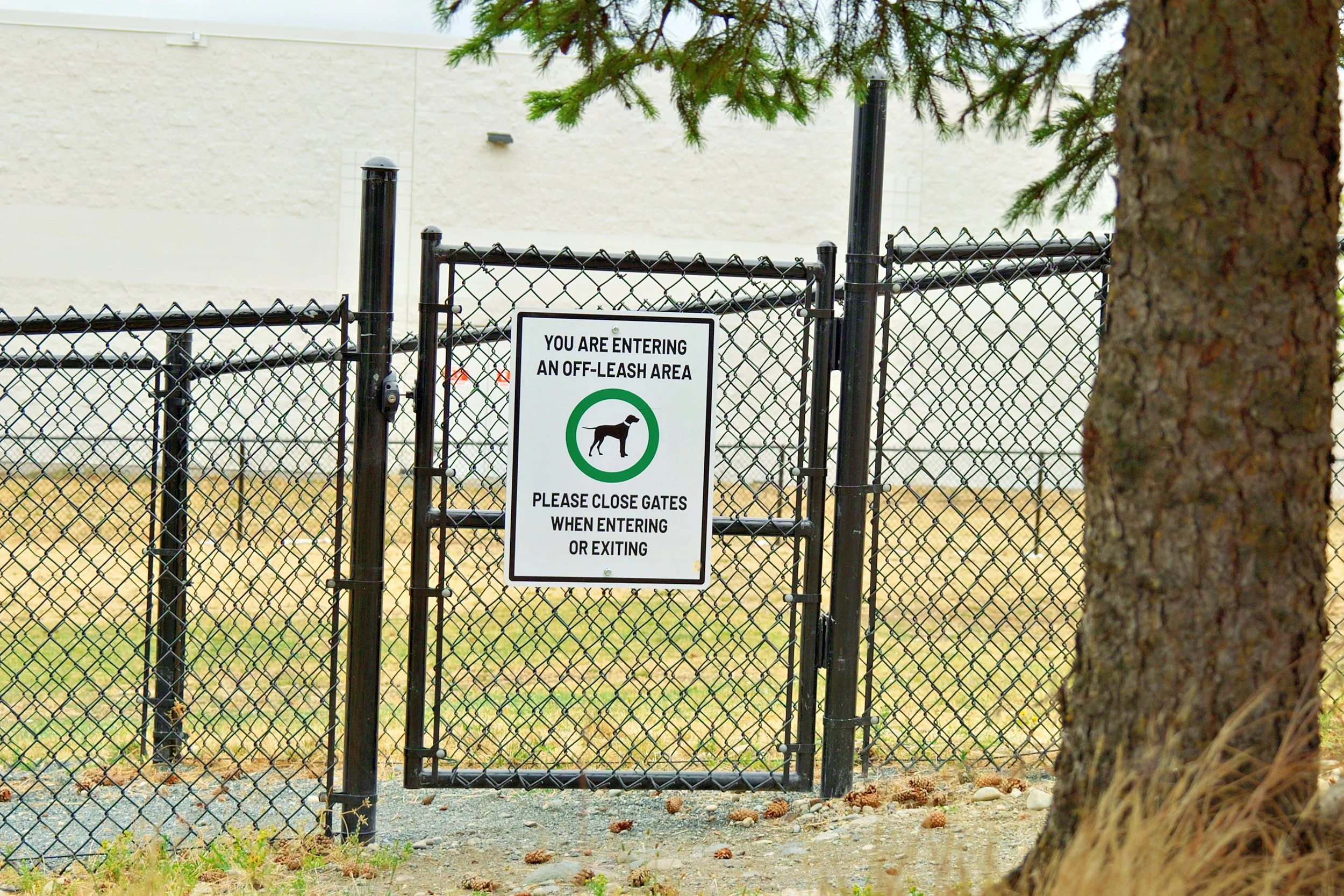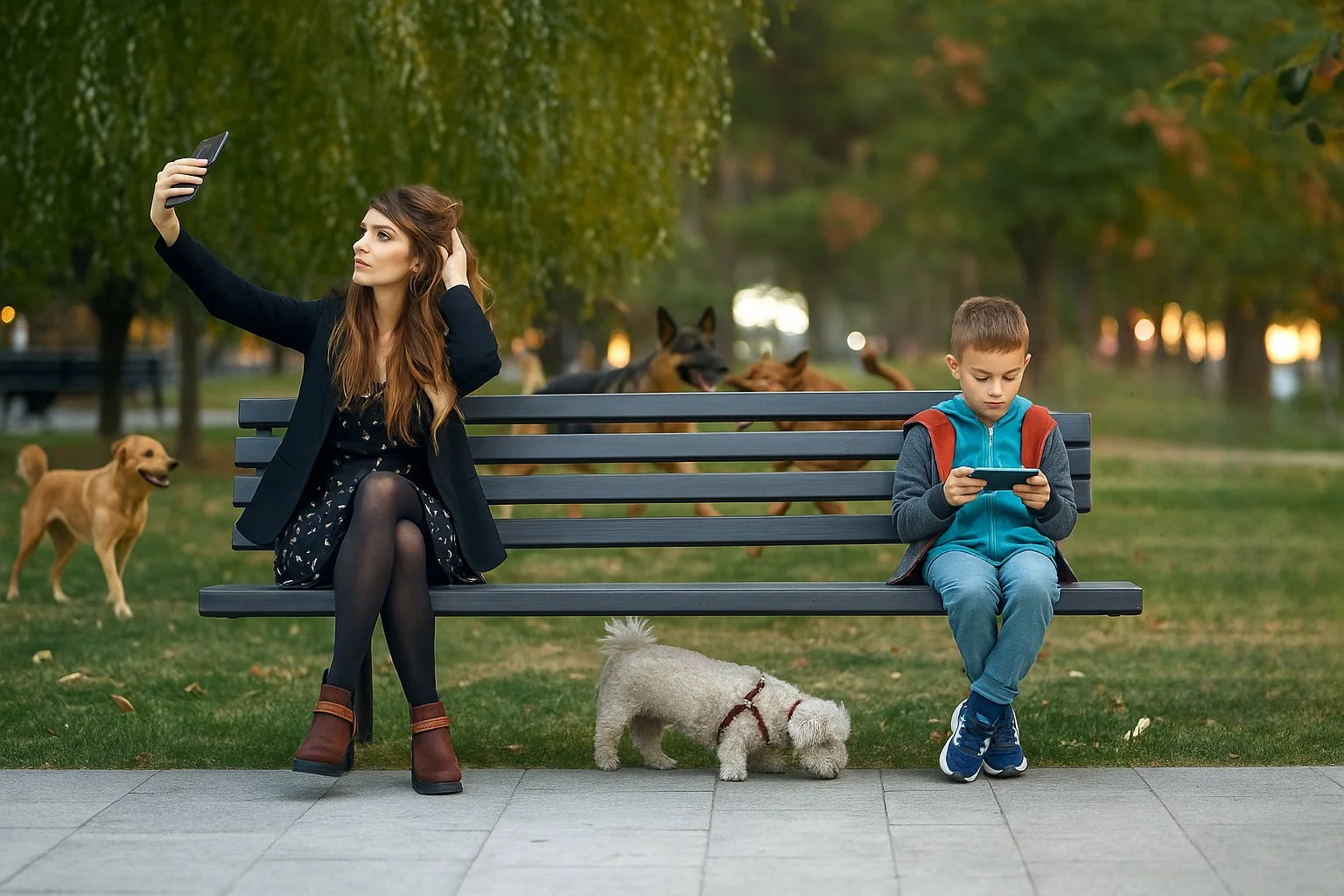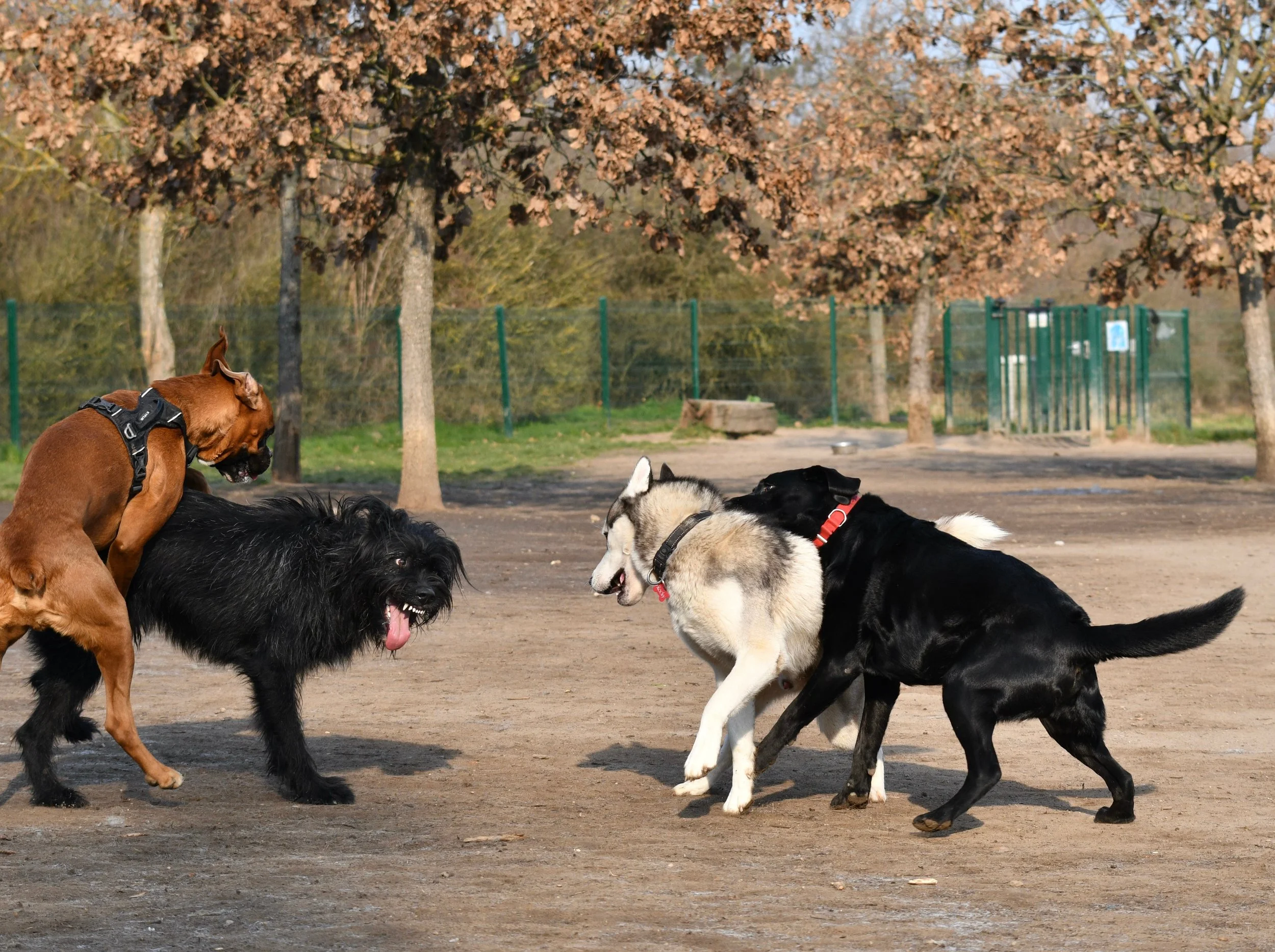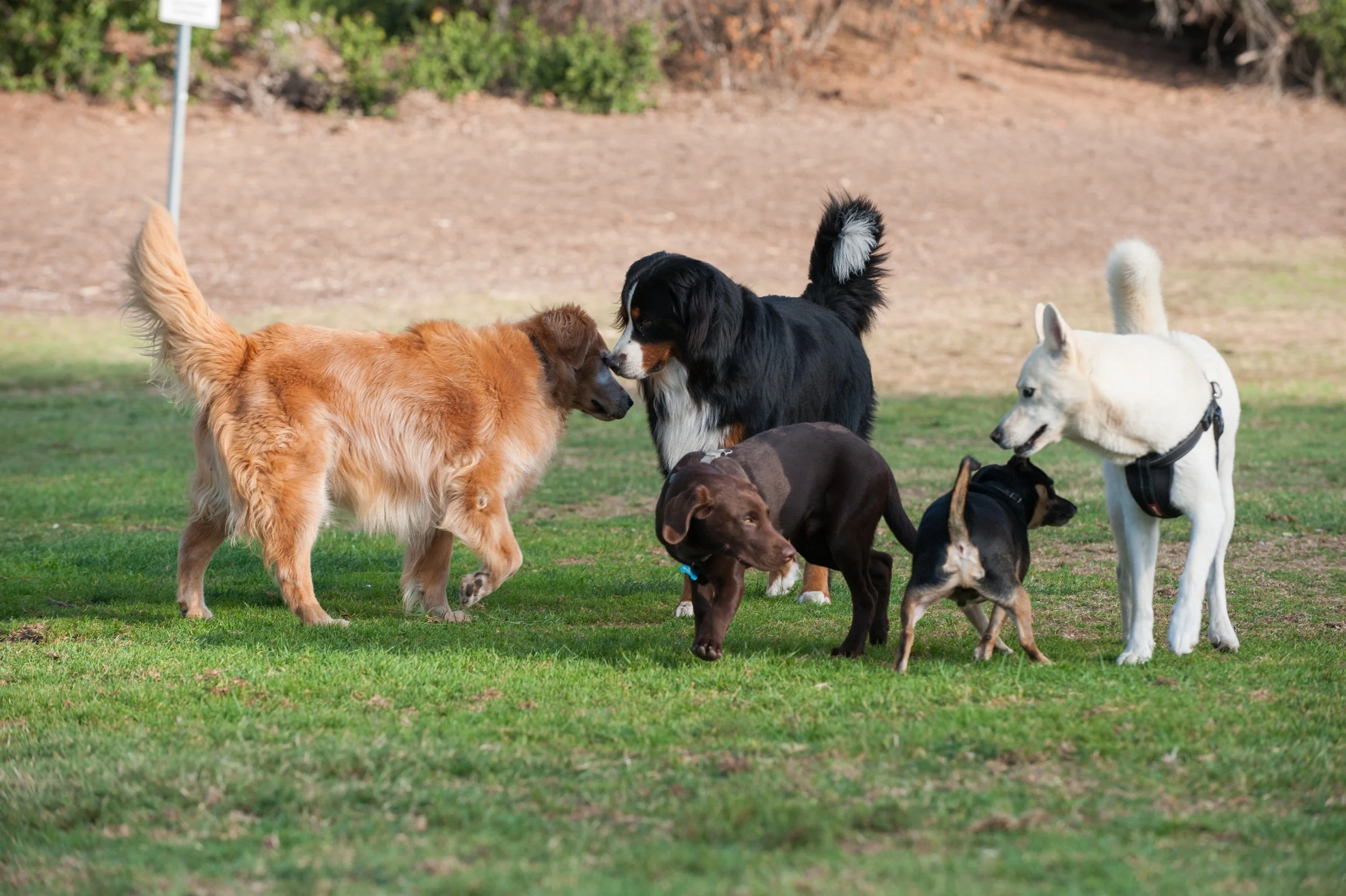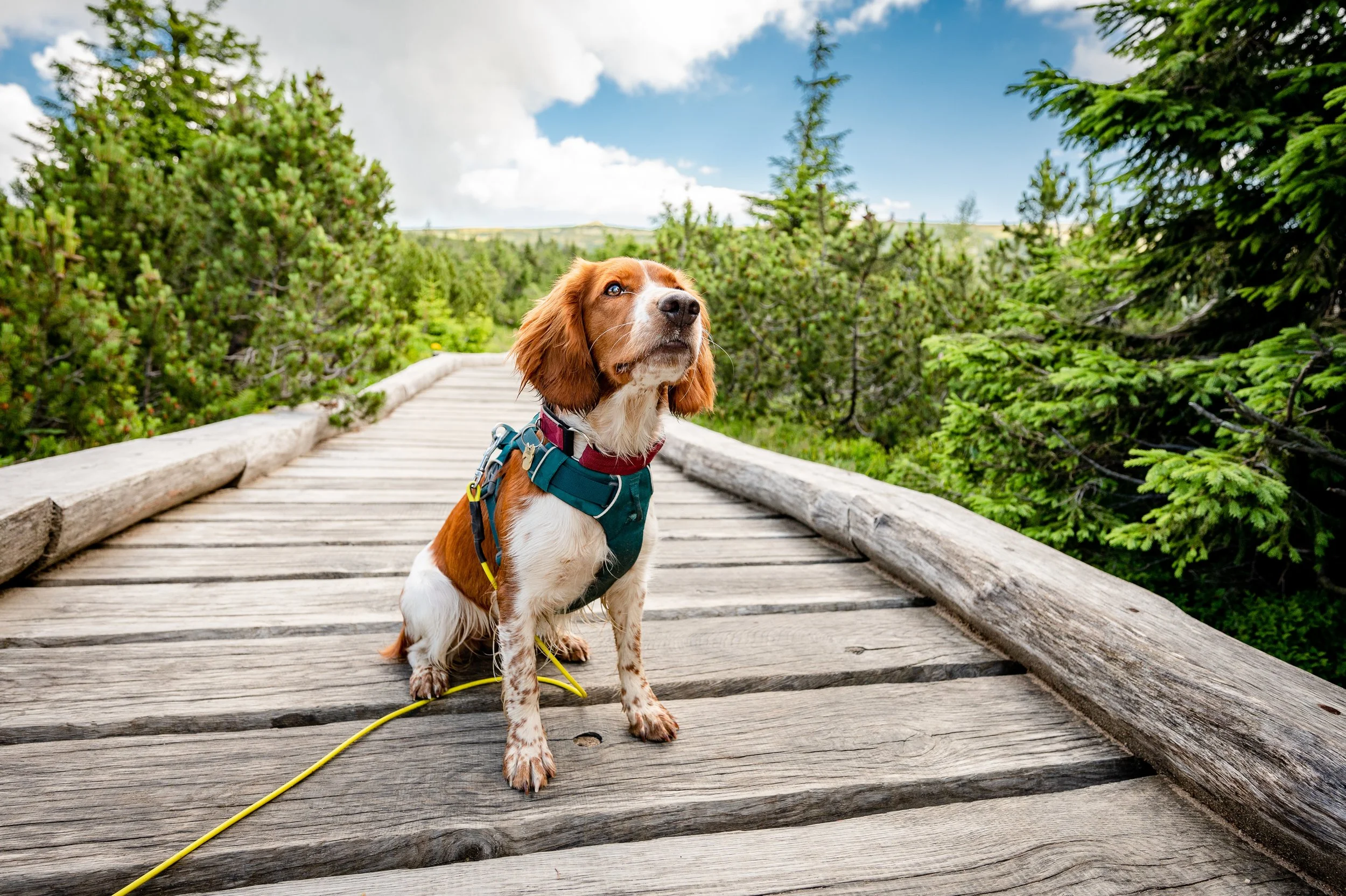The Not-So Hidden Risks of Dog Parks
There's no question dog parks are popular. They offer convenience for dog owners, especially in urban areas without private yards. However, dog parks come with significant risks that every dog owner should understand. Many dog trainers and veterinarians caution that while dog parks can provide exercise and the opportunity to socialize dogs with other dogs and people, they also present risks like fights, injuries, disease transmission, and undo stress for many dogs (Hoh, 2016).
I've been writing this article for years, sparked by a negative incident at a dog park in Toronto over 15 years ago. I never stepped foot in one again because I witnessed most of the risk factors shared throughout this article. More recently, I took it beyond my own anecdotal observations that day to an evidence-based look at the downside of dog parks—from inattentive owners and misread canine body language to the spread of illnesses—using research and statistics from international sources, dog expert input, and other anecdotal information. Expert-suggested safer alternatives to dog parks are also shared so you can make informed choices for you and your dog's well-being.
Why Do Dog Parks Carry Risks?
In a nutshell, dog parks concentrate a lot of dogs and people in a small area, which can aggravate certain problems that usually wouldn't happen on a routine walk. A recent systematic review of dog park studies notes that issues like dog waste (and the diseases it can carry) and canine aggression tend to be "[intensified] in dog parks because of the concentrated gathering of dogs.” In fact, dog feces left in parks can transmit parasites or illnesses, and dog fights and bites can be a serious issue in off-leash areas, leading to injuries (Chen et al., 2022). Even well-designed parks rely on owners to supervise their pets and unfortunately, not all owners manage their dogs responsibly. Below, is a break down of some of the most commonly documented risks at dog parks.
Inattentive Owners and “Friendly” Dogs
One of the biggest risk factors in dog parks isn’t the dogs at all—it’s the people. Distracted owners not paying attention leads to an escalation of problems quickly. In a 2019 survey of over 4,600 dog park users in Fairfax County, Virginia (USA), “inattentive owners” were the second most common concern reported (36% of respondents), ranked just below poor park conditions (Fairfax County Park Authority, 2020). When owners socialize with each other, chat on the phone, or stare at a screen instead of supervising, they might miss the warning signs of trouble—like a stiffening tail or a hard stare between dogs—until it’s too late. It only takes one negligent owner to let an aggressive or overexcited dog behave inappropriately and trigger a dog fight between two or multiple dogs.
A related issue is owners who overestimate their dog’s friendliness and ignore or miss canine body language. We’ve all heard someone laugh off their dog’s rude behavior with “Don’t worry, my dog is friendly!” , sometimes as their “friendly” dog is rudely bowling over another dog. Many people simply don't recognize or understand canine body language, which in this context is important as it indicates subtle and sometimes not-so-subtle signals of canine stress or aggression. For example, your dog might be uncomfortable or scared while another dog’s owner insists “they’re just playing”. If owners can’t recognize when a dog is anxious (tucked tail, trying to hide) or when play is tipping into bullying, they might leave a dog in a situation that could escalate into a fight. Animal behavior experts note that dogs are social animals, but it’s not natural for most dogs to play with large numbers of unfamiliar dogs—yet dog parks force them into exactly that scenario (Bradshaw, 2011 and Brix, 2021). Misunderstandings are common. A friendly dog can accidentally provoke a reactive one, or a high-energy dog might annoy an older dog. Without attentive owners to intervene early, these normal dog communication issues can lead to fights. In short, assuming every dog is “friendly” and will work it out on their own is risky and even might be a tragedy in waiting. As the Fairfax County survey data and countless anecdotes show, lack of owner supervision is a top contributor to dog park incidents. Every dog park user should stay alert and be ready to step in if needed, or remove their dog, at the first hint of trouble.
Too Many Dogs, Not Enough Control
“Animal behavior experts note that dogs are social animals, but it’s not natural for most dogs to play with large numbers of unfamiliar dogs—yet dog parks force them into exactly that scenario ”
Another problematic scenario is when one person brings multiple dogs at once. You may have seen a dog walker or well-meaning owner unload a large number of dogs into the park. The chaos that ensues can be hard to manage. No matter how well-trained the handler and dogs are, one person simply can’t monitor multiple dogs simultaneously in an off-leash free-for-all. As award-winning columnist Gina Spadafori observed, “One dog is hard enough to monitor properly; more than two is nearly impossible” (Spadafori, 2011).
Many cities recognize this risk and have rules to prevent one person from being outnumbered by their dogs. For example, many Canadian and American jurisdictions regulate the number of dogs a handler can have in an off-leash area at a time to ensure owners can react if issues arise. When someone shows up with five, ten, or more dogs, it’s simply unrealistic for them to manage each dog effectively, both behaviourally and by picking up after all of them. Uncontrolled groups also intimidate other park users—imagine trying to protect your single dog from a rambunctious group when their handler is halfway across the field, unable to recall or control them. If you witness this situation, it’s wise to leave the park. If you use a dog walker, consider asking them not to take your dog to the dog park if they’ll be managing many dogs at once, or alternatively seek out a dog walker who chooses not to use dog parks as part of their business model.
Dog Fights, Bullying and Injuries
When multiple unfamiliar dogs interact, there’s always a chance of conflict and the effects can be long lasting. It might just be a quick scuffle or a lot of noise with no injury, but that experience for a dog lacking confidence or a young developing dog can inform how they behave in the future, and that future behaviour may be problematic. Serious fights do occur at dog parks, and injuries to dogs and people are a documented risk. A national survey of over 1,000 dog owners in the United States found that 15% reported their dog having been attacked at a public dog park (Sniffspot, 2022). That’s roughly one in seven dog owners who experienced a dog-on-dog attack at the park. Even “minor” incidents—say one dog pinning another briefly—can have lasting psychological effects on the victim dog, potentially causing reactivity or fear aggression later (Sniffspot, 2022). In worse cases, dogs have been badly hurt or even killed. Dog trainers frequently share horror stories: dogs with puncture wounds, torn ears, or broken bones from fights, and distraught owners who “thought all the dogs were just playing” until it went wrong. Emergency veterinarians confirm seeing trauma from dog park fights, like deep punctures and chest wounds (Haynes, as cited in Hoh, 2016).
Why do these altercations happen? Sometimes it’s a truly aggressive dog being brought to a public park. But more often, fights start when normal dog play escalates or when a larger/high-energy dog “bullies” a smaller or timid dog. For example, imagine the park entry gate when a new dog enters and gets swarmed by a group of excited dogs already inside. This swarming behavior—crowding, chasing, barking at the newcomer—can overwhelm a dog and trigger defensive aggression. Renowned trainer Sue Sternberg identifies “Red Alert” behaviors in dog groups that often precede fights, including fast chases that turn into true predatory pursuits, mobbing, targeting (one dog repeatedly harassing another), bullying (body-slamming or pinning another dog), and group “hunting” behavior (Antolec, 2023). If these warning signs aren’t interrupted, a vulnerable dog can get injured. Unfortunately, in many reported cases owners did nothing or even laughed it off while such incidents occurred. In an ethnographic study of a California dog park, researchers observed episodes like a dog being chased and snarled at by multiple dogs while owners stood by, and a smaller dog being relentlessly mounted while people joked that “dogs will be dogs” (Case, 2014). Disturbingly, one dog’s ear was even bitten off in a fight, and the onlookers treated it as “resolved” merely because the aggressor’s owner paid the vet bill (Case, 2014). These anecdotes underline a sobering point—dog park injuries are real.
Disease and Parasite Exposure
Dog parks aren’t just a meeting place for dogs, they’re a meeting place for the germs and bugs those dogs might carry. With dozens of dogs relieving themselves and wrestling in close quarters, infection risks increase. One public health review noted that studies have found various zoonotic pathogens in dog parks, including common gastrointestinal parasites and bacteria, though the precise risk of transmission to other dogs (or humans) is still being studied (Rahim et al., 2018). It makes sense—if an infected dog has even microscopic residue on their fur, the next dog could pick up that organism. Intestinal parasites like Giardia and roundworms are classic examples, they spread via fecal matter. A 2014 study in Northern California tested 300 dog park dogs and found that 38% of them carried at least one intestinal pathogen (bacteria, virus, or parasite). The most common were Giardia (9% of dogs) and Cryptosporidium (5%), both of which can cause diarrhea. Crucially, the researchers noted that dogs who visited dog parks were more likely to have more frequent diarrhea, suggesting the park environment can contribute to GI illness spread. Another study in southwestern Ontario found Campylobacter bacteria (which can cause severe diarrhea and in immune-compromised individuals like puppies and seniors, even death) in a whopping 43% of dog park fecal samples, along with Giardia in 6% (Rahim et al., 2018). These pathogens can linger in soil or puddles. Giardia cysts, for instance, can survive severe environmental conditions for long periods of time.
Respiratory diseases are another concern. Canine influenza, kennel cough (Bordetella), and other respiratory viruses spread anywhere dogs congregate, including parks. If an owner brings a sick dog (perhaps unknowingly), a simple shared water bowl or a friendly sniff can pass the germs. Skin parasites like fleas, ticks, or mites can hop between dogs during play. And because vaccination rules aren’t enforced at many (or even most) public parks, there’s always a risk that some dogs are unvaccinated, which could expose others to preventable illnesses like parvovirus or distemper. A stark example occurred in early 2023 in Nevada, USA, where a deadly outbreak of parvovirus (a highly contagious and often fatal gastrointestinal virus) was traced back to a dog park – several puppies became ill after park visits, highlighting the importance of not bringing unvaccinated young dogs into these spaces (O'Kane, 2023, as cited by DVM360).
All that said, these risks can be mitigated. Veterinarians strongly advise keeping your dog up to date on vaccines (especially core vaccines like rabies, parvo, distemper, and any regionally recommended ones such as canine flu or leptospirosis) if you plan to use dog parks. Regular parasite prevention and fecal tests are also a good idea and periodic deworming or at least screening for parasites if your dog is a frequent park-goer. Never bring your dog to the park if they are showing signs of illness (coughing, diarrhea, lethargy). By being mindful, you can greatly cut down the disease dangers, though of course no public area can be completely germ-free.
Stress and Behavior Changes in Dogs
Not every dog enjoys dog parks, even if they seem “fine” on the surface. For some dogs, especially those that are shy, anxious, or not used to high-energy play, a dog park visit can be highly stressful. Dog trainer Teddy Green of Ontario-based Daytripper Dog Training shared, "Going to a dog park is like rolling the dice with the risk far outweighing the benefit. There’s no guarantee the other dogs have good social skills. Having been given some very bad advice, some people will attend a dog park because their dog isn’t friendly with other dogs, and they’ve been told their dog 'needs more socialization'. This alone puts all dogs present at risk, including the dog who struggles socially. Rather than dog parks, we recommend our clients schedule play dates with compatible dogs, ones with similar play styles and energy levels.”
“Renowned trainer Sue Sternberg identifies “Red Alert” behaviors in dog groups that often precede fights, including fast chases that turn into true predatory pursuits, mobbing, targeting (one dog repeatedly harassing another), bullying (body-slamming or pinning another dog), and group “hunting” behavior”
Cortisol levels are another indicator. Animal behavior researchers have studied dogs’ cortisol levels (a hormone associated with stress) during dog park visits. In one study, dogs had their saliva tested before and after 20 minutes in a dog park. The results showed that cortisol was significantly higher after time in the park, whereas it did not rise after a casual leash walk (Carrier et al., 2013). In other words, the park visit raised dogs’ stress hormones. This doesn’t mean all those dogs had a bad time—excitement and arousal can also raise cortisol— but it indicates the experience is physiologically arousing at the very least. The same study observed that almost all dogs (over 80%) showed at least one stress-related behavior (such as a tucked tail, pinned ears, avoiding interaction) during their park play, even while most also showed play behaviors (Todd, 2013). Dogs who were infrequent visitors had the highest cortisol spikes, suggesting that dogs not acclimated to the dog park environment found it overwhelming or stressful. Meanwhile, dogs that went often showed fewer visible stress signals and seemed to take the environment more in stride, though they too had elevated cortisol, likely due to excitement (Todd, 2013).
Safe Alternatives to Dog Parks
Given the risks outlined—from fights and injuries to health hazards and stress—you might wonder if there’s a better way to give your dog exercise and social time. The good news is yes, there are plenty of safe, fun alternatives to the traditional public dog park. Here are some options recommended by trainers and canine behavior experts:
Organize Small Playgroups: As suggested by an expert trainer above, instead of throwing your dog into a random mix of unknown dogs, create your own small playgroup of compatible dogs. This way, all owners present can actively supervise dogs they all know well. Structured play dates allow dogs to have fun and stay safe.
Dog Sports and Training Classes: If your dog has energy to burn, consider channeling it into a dog sport or class instead of free-for-all play. There are many to choose from—agility, obedience/rally, dock diving, flyball, nose work, barn hunt, and more. These activities provide physical exercise and mental stimulation in a controlled setting. If sports aren’t your thing, a training class (e.g. trick training) can tire out your dog mentally and physically. As one expert noted, “Dogs need to work their brains as much as their bodies” —a focused activity can leave a dog more satisfied than chaotic play (Sniffspot, 2022). An added bonus is you’ll deepen your bond with your dog and improve their obedience, which pays off in every aspect of life.
Outdoor Adventures: Sometimes the simplest alternative is the best—take your dog for a hike or jog in nature. Many dogs get more fulfillment from a long sniffy walk in the woods than from they chaos of a dog park. Hiking trails, quiet parks, or dog-friendly beaches allow your dog to explore new sights and smells. Using a long-line leash (15-30 feet) in a safe open area is a great way to give them a sense of freedom to run and play without losing control.
Doggy Daycare (Quality Matters): For dogs who truly love company and play, a reputable dog daycare can be a safer controlled environment than a public park. Good dog daycares have trained staff supervising at all times, screen dogs for behavior and vaccination status, and group dogs by size and play style. They also enforce rest breaks. Not all daycares are created equal, so do your homework: look for ones with small playgroups, knowledgeable staff, and strict health protocols (e.g. required vaccines, cleaning routines).
Mental Enrichment at Home: Don’t underestimate the power of puzzle toys, scent games, and training games at home. Food-dispensing puzzles, “find the treat” hiding games, lick mats, and short training sessions (teaching a new trick or cues) can provide enrichment that fulfills your dog in a calm, safe way (Pupford, 2023). For example, scatter feeding your dog’s dinner in the yard makes them use their nose to hunt kibble—a very satisfying canine activity that can reduce boredom. These activities are especially good for dogs who are reactive or shy and can’t easily handle group settings. They’ll be happier and more relaxed, without ever stepping paw in a dog park.
Private Off-Leash Spaces: If you still want to give your dog off-leash freedom without the unknown variables of a public park, consider renting a private dog park space. Services like Sniffspot (available in many countries) allow individuals to rent out fenced yards or fields for dogs. It’s like an Airbnb for dog playdates: you reserve a time and have the whole area just for you (and maybe a couple of your friends’ dogs). This eliminates encounters with strangers and unknown dogs entirely. Many trainers recommend these private spots as a safe alternative to public parks, since you control which dogs are present (Sniffspot, 2022).
You don’t have to rely on public dog parks to give your dog a happy, social life. There are many creative ways to exercise and entertain your dog that come with far fewer risks. It’s all about finding what suits your individual dog’s temperament and your comfort level as an owner.
Final Thoughts
The main takeaway of this article is that based on expert input, studies and anecdotal information, dog parks are not a neutral or positive experience for many dogs. Some dogs truly love the non-stop action, but plenty of others tolerate it at best, or find it very anxiety-provoking at worst. If your dog displays signs of discomfort—for example, staying close to you, showing a low/tucked tail, excessive drooling, or trying to hide—that is a red flag that they may not be having fun. As the researchers advised, dogs showing a lot of anxious body language at the park might be “reconsidered [for] exposure to this setting for welfare reasons” (Carrier et al., 2013, as summarized by Todd). As mentioned above, long-term stress can even lead to behavioral issues. Sometimes dogs start off merely overwhelmed at the park, but after a few bad experiences they develop fear or reactivity toward other dogs in general.
Dog parks aren’t inherently “bad”, in fact they arose as a solution to give urban dogs off-leash exercise and have provided countless dogs and owners joy and friendship. There are owners who use dog parks regularly without incident, and there are benefits: dogs can run freely, practice social skills, and owners can build community with fellow dog lovers. Especially in areas with limited space, off-leash parks can be an outlet. That said, this summary of serious risks backed by evidence-based sources shows that caution is warranted. Public dog parks are largely unregulated environments that rely on an honor system and assume owners are vigilant. When that breaks down—as studies and surveys from the U.S., Canada, Australia, and elsewhere have shown—the consequences can range from annoying (stepping in poop) to truly tragic (a beloved dog is seriously injured and/or traumatized).
One final note on socialization. This is something we support our puppy owners on understanding beginning well before they take their puppy home. It's important that owners have a socialization plan in place for their puppies and dogs, focusing on those actions that build confidence, curiosity, optimism and more. Socializing dogs is not about quantity, but quality. A dog doesn’t need a hundred random dog and people acquaintances to be well-socialized; a few trusted dog friends and positive experiences are far more valuable. Ultimately, the best environment for your dog is one where they thrive, where they can have fun and be safe at the same time. By balancing the pros and cons and considering some of the safer alternatives, you can ensure your dog stays out of harm’s way and enjoys a healthy, happy life—whether that’s inside or outside the dog park fence.
References
Antolec, D. (2023, August 23). Visiting Public Dog Parks, or Not. Pet Professional Guild – Pets and Their People Blog.
Bradshaw, J. (2011). Dog Sense: How the New Science of Dog Behavior Can Make You A Better Friend to Your Pet. Basic Books.
Brix, R. (2021, November 18). Dog Parks: The Good, the Bad, and the Reality. BARKS from the Guild (Pet Professional Guild Blog).
Carrier, L. O., Cyr, A., Anderson, R. E., & Walsh, C. J. (2013). Exploring the dog park: Relationships between social behaviours, personality and cortisol in companion dogs. Applied Animal Behaviour Science, 146(1–4), 96–106.
Case, L. (2014, Feb 12). Dog Park People. The Science Dog Blog.
Chen, S., Wu, Z., Sleipness, O. R., & Wang, H. (2022). Benefits and conflicts: A systematic review of dog park design and management strategies. Animals (Basel), 12(17), 2251.
Fairfax County Park Authority. (2021). Dog Park Study Report (public survey results). Fairfax County, VA.
Hoh, A. (2016, April 11). Off-leash dog parks branded as ‘dangerous’ by professional trainer. ABC News (Australia).
Pendergrass, J. (2016, Dec 7). Danger at the Dog Park? Enteropathogens Detected in Dogs Visiting Dog Parks. DVM360 Magazine.
Rahim, T., Barrios, P. R., McKee, G., McLaws, M., & Kosatsky, T. (2018). Public health considerations associated with the location and operation of off-leash dog parks. Environmental Health Review, 61(1), 8–15.
Sniffspot. (2022). The State of Public Dog Parks Across the United States (Sniffspot national dog owner survey report).
Spadafori, G. (2011, July 5). Do professional dog walkers keep too many dogs on leash? Vetstreet.
Todd, Z. (2013, December 11). Should you take your dog to the dog park? Companion Animal Psychology. https://www.companionanimalpsychology.com/2013/12/should-you-take-your-dog-to-dog-park.html

